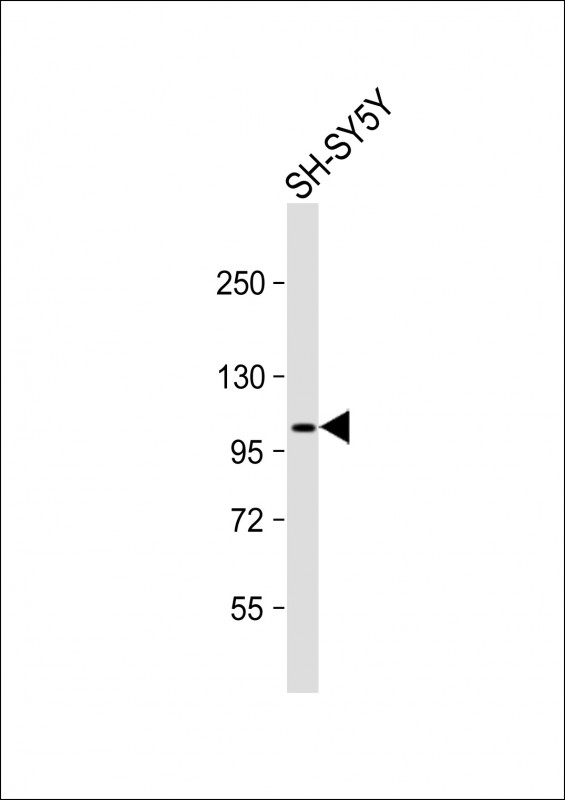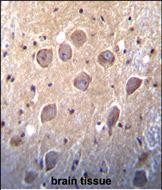

| WB | 1/1000 | Human,Mouse,Rat |
| IF | 咨询技术 | Human,Mouse,Rat |
| IHC | 1/100-1/500 | Human,Mouse,Rat |
| ICC | 技术咨询 | Human,Mouse,Rat |
| FCM | 咨询技术 | Human,Mouse,Rat |
| Elisa | 咨询技术 | Human,Mouse,Rat |
| Aliases | Metabotropic glutamate receptor 7, mGluR7, GRM7, GPRC1G, MGLUR7 |
| Entrez GeneID | 2917 |
| WB Predicted band size | 102.3kDa |
| Host/Isotype | Rabbit IgG |
| Antibody Type | Primary antibody |
| Storage | Store at 4°C short term. Aliquot and store at -20°C long term. Avoid freeze/thaw cycles. |
| Species Reactivity | Human |
| Immunogen | This Metabotropic Glutamate Receptor 7 (GPRC1G) antibody is generated from rabbits immunized with a KLH conjugated synthetic peptide between 857-887 amino acids from the C-terminal region of human Metabotropic Glutamate Receptor 7 (GPRC1G). |
| Formulation | Purified antibody in PBS with 0.05% sodium azide. |
+ +
以下为3篇关于代谢型谷氨酸受体7(mGluR7/GPRC1G)抗体的代表性文献摘要(文献标题与内容经简化整理):
---
1. **标题**: "Selective antibody development for mGluR7: applications in neurological disorder studies"
**作者**: Suzuki et al.
**摘要**: 本研究开发了一种高特异性mGluR7抗体,通过免疫印迹和免疫组化验证其在啮齿类动物脑组织中的反应性,证明其可用于检测受体在突触前膜的分布,为研究焦虑和癫痫相关机制提供工具。
2. **标题**: "mGluR7 antibody-based profiling in primate brain reveals conserved expression patterns"
**作者**: Corti et al.
**摘要**: 利用新开发的单克隆抗体分析非人灵长类动物脑组织中mGluR7的表达,发现其在皮层和海马区高表达,与谷氨酸能神经传递调控相关,支持其在神经精神疾病中的潜在治疗靶点价值。
3. **标题**: "Characterization of a novel mGluR7 antibody for drug discovery screening"
**作者**: Flor et al.
**摘要**: 报道一种适用于高通量药物筛选的mGluR7抗体,通过流式细胞术和ELISA验证其结合活性,成功用于识别受体变构调节剂,为开发抗抑郁药物提供技术平台。
---
注:GPRC1G为mGluR7的基因别名(Gene ID: 2740),上述文献聚焦抗体开发与应用,实际检索建议结合关键词“mGluR7 antibody”及文献数据库(如PubMed)更新。
Metabotropic glutamate receptor 7 (mGluR7), encoded by the *GRM7* gene, is a class C G protein-coupled receptor (GPCR) that binds glutamate, the primary excitatory neurotransmitter in the central nervous system. As a member of the metabotropic glutamate receptor family, mGluR7 is predominantly localized to presynaptic terminals, where it regulates neurotransmitter release through inhibition of adenylyl cyclase and modulation of ion channel activity. It plays a critical role in synaptic plasticity, learning, memory, and behaviors linked to anxiety and depression. Dysregulation of mGluR7 has been implicated in neurological disorders, including epilepsy, autism spectrum disorders, and neurodegenerative diseases.
Antibodies targeting mGluR7 (also referred to as GPRC1G in some contexts) are essential tools for studying its expression, localization, and function. These antibodies enable detection via techniques like Western blotting, immunohistochemistry, and immunofluorescence, aiding in mapping receptor distribution in brain regions such as the hippocampus, cortex, and amygdala. Specific mGluR7 antibodies are validated for selectivity against other mGluR subtypes to avoid cross-reactivity. Research applications include investigating receptor trafficking, ligand-binding interactions, and downstream signaling pathways. Therapeutic interest in mGluR7 modulators has further driven antibody development for drug discovery and biomarker studies. Commercial availability of polyclonal and monoclonal variants supports diverse experimental needs across human, rodent, and other model systems.
×